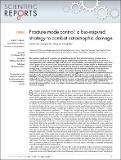Fracture mode control: a bio-inspired strategy to combat catastrophic damage
Author(s)
Yao, Haimin; Xie, Zhaoqian; He, Chong; Dao, Ming
DownloadYao-2015-Fracture mode control.pdf (1.074Mb)
PUBLISHER_CC
Publisher with Creative Commons License
Creative Commons Attribution
Terms of use
Metadata
Show full item recordAbstract
The excellent mechanical properties of natural biomaterials have attracted intense attention from researchers with focus on the strengthening and toughening mechanisms. Nevertheless, no material is unconquerable under sufficiently high load. If fracture is unavoidable, constraining the damage scope turns to be a practical way to preserve the integrity of the whole structure. Recent studies on biomaterials have revealed that many structural biomaterials tend to be fractured, under sufficiently high indentation load, through ring cracking which is more localized and hence less destructive compared to the radial one. Inspired by this observation, here we explore the factors affecting the fracture mode of structural biomaterials idealized as laminated materials. Our results suggest that fracture mode of laminated materials depends on the coating/substrate modulus mismatch and the indenter size. A map of fracture mode is developed, showing a critical modulus mismatch (CMM), below which ring cracking dominates irrespective of the indenter size. Many structural biomaterials in nature are found to have modulus mismatch close to the CMM. Our results not only shed light on the mechanics of inclination to ring cracking exhibited by structural biomaterials but are of great value to the design of laminated structures with better persistence of structural integrity.
Date issued
2015-01Department
Massachusetts Institute of Technology. Department of Materials Science and EngineeringJournal
Scientific Reports
Publisher
Nature Publishing Group
Citation
Yao, Haimin, Zhaoqian Xie, Chong He, and Ming Dao. “Fracture Mode Control: a Bio-Inspired Strategy to Combat Catastrophic Damage.” Sci. Rep. 5 (January 26, 2015): 8011.
Version: Final published version
ISSN
2045-2322